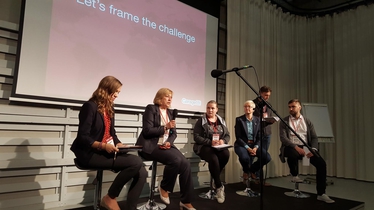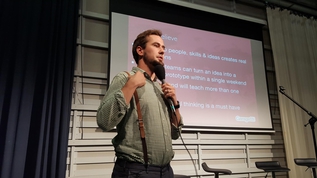Garage48 is delighted to contribute to a problem that matters so much in a huge scope. As human trafficking affects millions of people around the globe, Garage48 feels fortunate to help out in finding solutions for this problem by connecting NGOs with technology enthusiasts. The hackathon was started off by first making an insight to trafficking in persons and introducing the key people that work on this very difficult matter every day. Additionally, as the Garage48 Trafficking in Persons hackathon is organised in co-operation with the Embassy of the United States in Tallinn, Estonia who is also working to find solutions on how we can stop this problem for good. The Ambassador to Estonia Jeffrey Levine, who also give his last public appearance, said the best ideas come from Garage48, so he only had to ask 1 question from the audience - are you ready for disruption?
The U.S. Ambassador to Estonia Jeffrey D. Levine is very pleased to support this hackathon, as the mentors from the US said that Garage48 works on the hackathon process better than anyone else. The pitches are always interesting and it’s great to see people form teams, besides all the products that will be developed during the 48 hours. As we have an intense working weekend ahead of us, so let us begin with this positive note at this severe issue.
To work on this issue, we not only have participants, but we also have global representation of human trafficking experts present, including experts from Washington and from the Government of Estonia. The representative from the Ministry of Social Affairs Estonia said both governmental officials and NGOs will be glad to use the practical products the teams are going to produce over the weekend!
But, before we go to the presentation of the ideas, we first need to ask - what is human trafficking? Renee Huffman from the U.S. State Department of Trafficking in Persons tells us that human trafficking occurs when an individual is exploited through fraud, force or compulsion. Anyone can be a victim of trafficking. Trafficking can also happen in every sector – in restaurants, agriculture, construction, manufacturing etc.It is important to be aware of the different forms of exploitation. For which she invited her colleagues from different part of the world to a panel discussion in order to give local and region perspective.The panel discussion was joined by Ecaterina Berejan (Moldova), Kristina Tiškevičiené (Lithuania), Roman Krolov (Estonia) and Sirle Blumberg (Estonia).
Some ideas that rose up from the discussion to take into consideration:
- Not all our victims have very good phones or
computers, so don’t think that they all have iPhones. Better think that they might have the older phone around.
- People here at home also need to be aware of the threats, so inform people also locally and nearby.
- We need to advertise, if we make good monitoring system on the internet, we could have better assistance the victims.
- Great link: Sourcemap.me, which helps companies to track where the ingredients were made of the products they consume and where it was made, by whom etc.
- The classical profile of a victim: for sexual exploitation is most vulnerable are young females, single moms, from small towns, who rely on welfare. Who are single and are looking for partnership, who then get into it social networking.
- Labor exploitation victims: males and females, very ordinary people, over 40. They trust Facebook and their trust friends, they could also be educated, but most have vocational background. Now they live outside of Estonia – Sweden, Finland, Norway. They’ve may be suffering many months, before they decide to act and say something.
- Advice: follow the business. The NOGs work with people, but at this this event we will try to work with the business.
The most vulnerable people are not surprisingly the youth and the single parents, who look for ways to find better income. A lot of children, who don't have parents are also most likely to get victimised. We need to work in innovations, because the traffickers will be ahead of time. The traffickers themselves consider themselves to be businessmen/women and the victims never think of themselves of victims, this is the language of the specialist, the NGOs. Which makes the work of course more difficult, because it might sometimes happen that they victims don't know their basic human right are being violated immensely.
Prostitution is a massive problem, that is very lucrative to the traffickers. In Estonia we see prostitution as a social problem. If some people may think the prostitutes enjoy their work, then this is only the case for 3% of
the prostitutes, the 97% are victims. There cannot be a “happy” prostitute, even if
they look like this. There is a sex industry behind it, which in reality is a very sad world.
Renee also spoke about the Tech Camp in Nepal, where the goal was to identify technological solutions. Unique individuals came together, because the people of Nepal are a major source of human trafficking victims. A few of their solutions: a platform for workers to get info about the recruiters, a website that would provide financial calculation for the workers, an app for safe reporting about issues etc.
Now let's go to the presentations of our participants. We are thankful to share 22 ideas that all could help to save the victims of human trafficking and to stop the horrifying business for good:- A bot that checks when a job comes up if the person should be aware of it and call a hotline.
- To
create information site, which has info of what you should do before you go working abroad, for example upload the copy of your document.
- An
app that check your coordinates and takes your photo, which helps the victims
to get recognised and to report some suspicious activity.
- A educational
game of a simulation of a quest, where you are a social worker or a policeman
and you are looking for the human trafficker. So you can send a message
through a game (Android game) to prevent this problem.
- An
app to get information and rating about recruiting agencies, to know that there
is a real person reporting it.
- A rape alarm that unleashes a powerful noise and will have a
location alarming technique.
- To build a site to write the stories of the victims anonymously
Ideas that sadly could not gather a team, but had much potential:
8. To monitor the information from social networks to tell them if a target group is vulnerable
9. Simple and effective notification app that sends an instant alert
10. A computer game with a plot on real stories with victims as characters. The computer could be an instrument that people really use.
11. To insert nanotechnology to makeup or jewelry for the victims, as they need to look pretty for the client, the signal will go to the firm that helps people up
12. To develop a tool that a NGO specialist can spy an ad - the text etc. so the system will learn the techniques to analyze over time
13. A signal for the police if in one region there is much trafficking.
14. A simple portal for the victims to share their experience, to send the message to ordinary people to warn them
15. A portal, where everyone can share their experience about recruitment agencies
16. Monitoring of internet ads for the propose of the identifying people of risk and the victims of human trafficking
17. Idea of smell bomb
18. A website with simple and practical checklist before you go abroad
19. For funds How data can be used for prevention
20. An app that reports all of us of people that might be in trouble, the pic is geo-located
21. Safety check for Facebook
22. Mentor pitching: An adult dating site, to fight back with the weapons the traffickers are using


